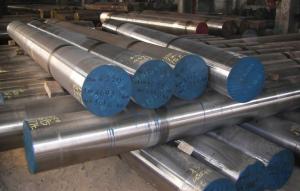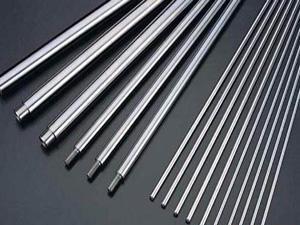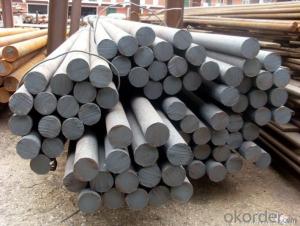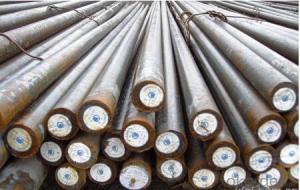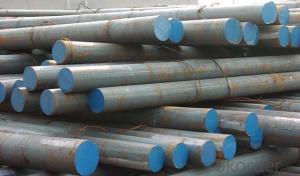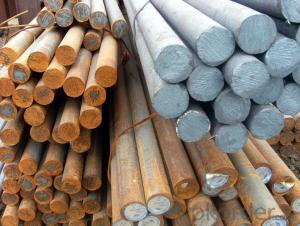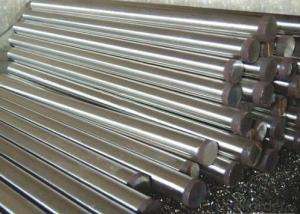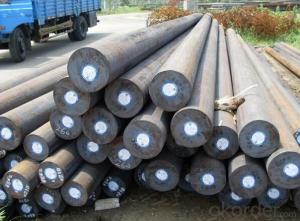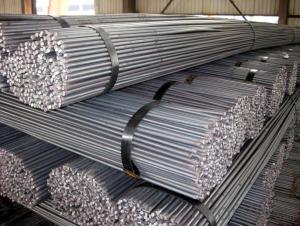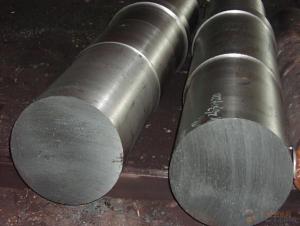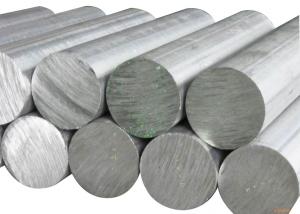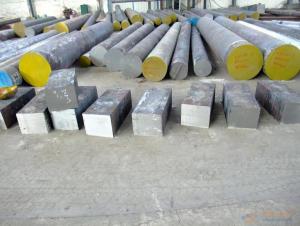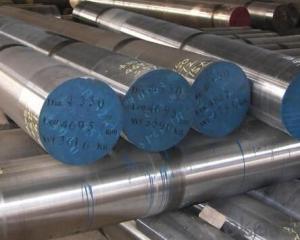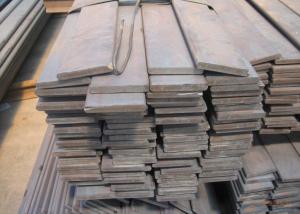Special Steel Round Bar for Bearing
- Loading Port:
- China Main Port
- Payment Terms:
- TT or LC
- Min Order Qty:
- -
- Supply Capability:
- -
OKorder Service Pledge
OKorder Financial Service
You Might Also Like
Product Description:
OKorder is offering Bearing steel at great prices with worldwide shipping. Our supplier is a world-class manufacturer of steel, with our products utilized the world over. OKorder annually supplies products to European, North American and Asian markets. We provide quotations within 24 hours of receiving an inquiry and guarantee competitive prices.
Product Applications:
Bearing steel is used for manufacturing ball, roller bearing steel and rings. Bearing in work is under great pressure and friction, so have high demands bearing steel and hardness and resistance, and high elastic limit.
Bearing steels are used for ball and roller bearing applications and are comprised of low carbon steels and high carbon through harden able steel.
For example, bearing ring, steel rolling mill, machinery, 100Cr6 bearing steel ball is widely used in high-speed and low-noise bearing, bicycle, motorcycle, automobile, bags electronically.
Product Advantages:
OKorder's Bearing steel are durable, strong, and resist corrosion.
Main Product Features:
· Premium quality
· Prompt delivery & seaworthy packing (30 days after receiving deposit)
· Corrosion resistance
· Can be recycled and reused
· Mill test certification
· Professional Service
· Competitive pricing
Product Specifications:
Grade | bearing steel EN-31 |
Dimensions | Diameter: 20-280mm Length: 2000-5800mm |
Shape | Round Bar |
Type | High chromium bearing steel |
HBS | <220 |
Standard | AISI |
Technique | Hot Rolled |
FAQ:
Q1: Why buy Materials & Equipment from OKorder.com?
A1: All products offered byOKorder.com are carefully selected from China's most reliable manufacturing enterprises. Through its ISO certifications, OKorder.com adheres to the highest standards and a commitment to supply chain safety and customer satisfaction.
Q2: How do we guarantee the quality of our products?
A2: We have established an advanced quality management system which conducts strict quality tests at every step, from raw materials to the final product. At the same time, we provide extensive follow-up service assurances as required.
Q3: How soon can we receive the product after purchase?
A3: Within three days of placing an order, we will begin production. The specific shipping date is dependent upon international and government factors, but is typically 7 to 10 workdays.
Images:
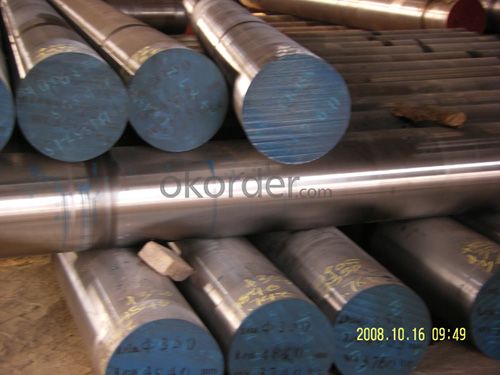
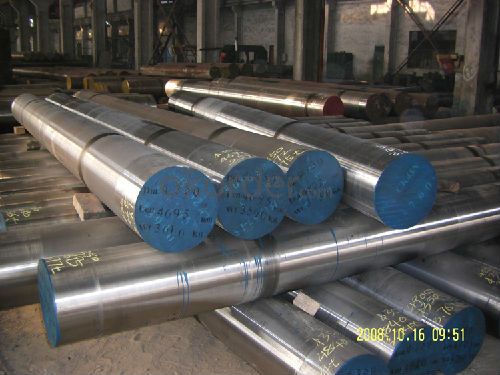
- Q: How does special steel enhance the performance of cutting tools?
- Special steel enhances the performance of cutting tools by providing increased durability, hardness, and resistance to wear and deformation. This allows cutting tools to maintain their sharpness and precision for longer periods, resulting in improved cutting efficiency and effectiveness.
- Q: How does special steel contribute to the durability of products?
- Special steel contributes to the durability of products due to its unique properties and composition. It is designed to have increased strength, hardness, and resistance to wear and corrosion, making it suitable for demanding applications. Special steel enhances the structural integrity and longevity of products, ensuring they can withstand heavy loads, extreme temperatures, and harsh environments without compromising performance or safety.
- Q: What are the different coating and plating options for special steel?
- The different coating and plating options for special steel include electroplating, hot-dip galvanizing, powder coating, PVD (Physical Vapor Deposition) coating, and ceramic coating. Each option offers unique benefits such as increased corrosion resistance, improved aesthetics, enhanced durability, or specific functional properties, allowing the special steel to be tailored to various applications and environments. The choice of coating or plating depends on factors such as the desired outcome, budget, substrate material, and intended use of the special steel.
- Q: What are the common challenges in heat treating special steel?
- Heat treating special steel poses a range of difficulties. One of the main challenges is to attain the desired hardness and strength while maintaining the desired microstructure. Special steels often necessitate specific heat treatment processes, such as quenching and tempering, to achieve the desired mechanical properties. However, the high alloy content in these steels can make it challenging to achieve uniform heat distribution and control the cooling rate during quenching, resulting in inconsistent hardness and potential distortion. Another obstacle in heat treating special steel is managing residual stresses. During the heating and cooling process, differential thermal expansion and contraction can cause stress to accumulate within the steel, potentially leading to cracking or distortion. To minimize these stresses, it is crucial to employ proper heat treatment techniques, such as preheating and controlled cooling rates. Special steels also require stringent cleanliness standards, as impurities or non-metallic inclusions can adversely affect their mechanical properties. Ensuring the cleanliness of the steel prior to heat treatment can be difficult and may entail additional steps, such as degreasing, pickling, or using protective atmospheres during heat treatment. Furthermore, some special steels are highly susceptible to overheating, which can result in grain growth and the loss of desired properties. To prevent overheating and ensure consistent outcomes, precise temperature control and monitoring are essential. Finally, heat treatment of special steels must take into account specific time-temperature transformation (TTT) and continuous cooling transformation (CCT) characteristics. Understanding and adhering to the appropriate heating and cooling cycles are crucial for achieving the desired microstructure and properties. In conclusion, the challenges in heat treating special steel include achieving the desired hardness and microstructure, managing residual stresses, ensuring cleanliness, preventing overheating, and adhering to specific time-temperature transformation characteristics. Overcoming these challenges necessitates expertise, precise control, and strict adherence to heat treatment protocols.
- Q: What are the different surface protection methods used for special steel?
- To enhance the durability and resistance of special steel, several methods of surface protection are employed. Galvanizing is a commonly utilized technique, wherein a layer of zinc is applied to the steel surface. This shields the steel from corrosion and rusting, thereby prolonging its lifespan and preserving its appearance. Galvanizing can be executed through either hot-dip galvanizing or electroplating, depending on the specific requirements of the steel. Another method is powder coating, which entails the application of a dry powder to the steel surface, followed by curing at high temperatures. This results in the formation of a protective layer that is impervious to chipping, scratching, and fading. Powder coating is often chosen for its aesthetic benefits, as it offers a wide range of color options and can enhance the visual appeal of the steel. Furthermore, various types of paints and coatings can be employed to protect special steel. These coatings can be applied using a spray or brush technique, and they serve as a barrier against corrosion, chemicals, and UV radiation. Depending on the specific needs and environmental conditions, epoxy, polyurethane, and acrylic coatings are frequently utilized. Moreover, stainless steel possesses inherent resistance to corrosion due to its composition. However, to further safeguard it, passivation can be employed. Passivation involves a chemical treatment that eliminates iron particles from the surface, thus preventing corrosion and improving the steel's resilience against staining and pitting. Lastly, a layer of ceramic or enamel coating can be applied to protect special steel. These coatings offer high levels of resistance to heat, chemicals, and physical abrasion. They can be applied through spraying or dipping and are commonly used in environments where the steel will be exposed to extreme conditions or aggressive substances. In conclusion, the various surface protection methods utilized for special steel encompass galvanizing, powder coating, painting, passivation, and ceramic/enamel coating. These methods aim to enhance the steel's durability, corrosion resistance, and overall lifespan, ensuring that it can withstand diverse environmental factors while maintaining its structural integrity.
- Q: How does special steel contribute to the transportation sector?
- The transportation sector relies heavily on special steel due to the numerous benefits it offers. Special steel plays a pivotal role in improving the efficiency, safety, and overall performance of vehicles. One primary advantage is its high strength-to-weight ratio, which allows manufacturers to reduce vehicle weight without compromising structural integrity. As a result, fuel efficiency improves, emissions decrease, and operating costs are lowered. Furthermore, special steel exhibits exceptional resistance to corrosion, making it especially advantageous in areas with severe weather conditions or exposure to saltwater, such as coastal regions or winter roadways where salt is used for ice melting. This corrosion resistance helps extend the lifespan of transportation infrastructure, such as bridges, tunnels, and railways, thus minimizing maintenance and replacement expenses. Another important aspect is the outstanding impact resistance of special steel. It can withstand heavy impacts and collisions, making it ideal for constructing vehicle frames, body panels, and safety components. This enhances passenger safety and reduces the likelihood of severe injuries during accidents. Special steel also plays a crucial role in producing high-performance engines and powertrains. Steel alloys with specific characteristics, such as high temperature and wear resistance, are utilized in manufacturing critical engine components like pistons, crankshafts, and camshafts. This ensures long-lasting and efficient engine performance, resulting in improved reliability and reduced downtime. Moreover, special steel contributes to advancements in electric and hybrid vehicles. Certain steel alloys possess unique properties that enable the development of lightweight battery packs, electric motor components, and charging infrastructure. These advancements facilitate the shift towards greener transportation options and help decrease the environmental impact of the sector. Overall, special steel has a profound influence on the transportation sector by providing lightweight, durable, corrosion-resistant, and impact-resistant materials. It not only enhances the performance and safety of vehicles but also contributes to the establishment of sustainable and efficient transportation systems.
- Q: Can special steel be used for nuclear power plant components?
- Yes, special steel can be used for nuclear power plant components. Special steel alloys such as stainless steel, low-alloy steels, and nickel-based alloys are commonly used in nuclear power plants due to their excellent mechanical properties, resistance to corrosion, and ability to withstand high temperatures and radiation. These materials are specifically designed to meet the stringent safety and performance requirements of nuclear power plant components, ensuring the integrity and reliability of the plant.
- Q: Can special steel be used in construction?
- Yes, special steel can be used in construction. Special steel, also known as alloy steel, offers superior strength, durability, and resistance to corrosion and wear compared to regular steel. It is commonly used in the construction of high-rise buildings, bridges, and other structures that require exceptional strength and longevity. Additionally, special steel can be customized to meet specific project requirements, making it a versatile choice for construction applications.
- Q: How does the cost of special steel compare to regular steel?
- The cost of special steel is generally higher compared to regular steel. Special steel is specifically designed and produced to possess exceptional properties and characteristics that regular steel does not have. It undergoes additional processes such as alloying, heat treatment, or specialized manufacturing techniques to enhance its strength, durability, corrosion resistance, and other desirable attributes. These added steps in production increase the overall cost of special steel. On the other hand, regular steel is more readily available and is produced on a larger scale. It is often used for general purposes and applications where high-performance qualities are not required. Regular steel is relatively cheaper due to its lower production costs and wider availability in the market. However, it is important to note that the cost comparison between special steel and regular steel can vary depending on various factors such as the specific type of steel, the quantity being purchased, market conditions, and any additional customization required. Therefore, it is advisable to consult with steel suppliers or specialists to get accurate pricing information based on specific requirements.
- Q: What are the main factors that determine the cost of special steel?
- The main factors that determine the cost of special steel include the raw material costs, production techniques and processes involved, the complexity of the steel's composition, the level of customization required, and market demand and supply dynamics.
Send your message to us
Special Steel Round Bar for Bearing
- Loading Port:
- China Main Port
- Payment Terms:
- TT or LC
- Min Order Qty:
- -
- Supply Capability:
- -
OKorder Service Pledge
OKorder Financial Service
Similar products
Hot products
Hot Searches
Related keywords
